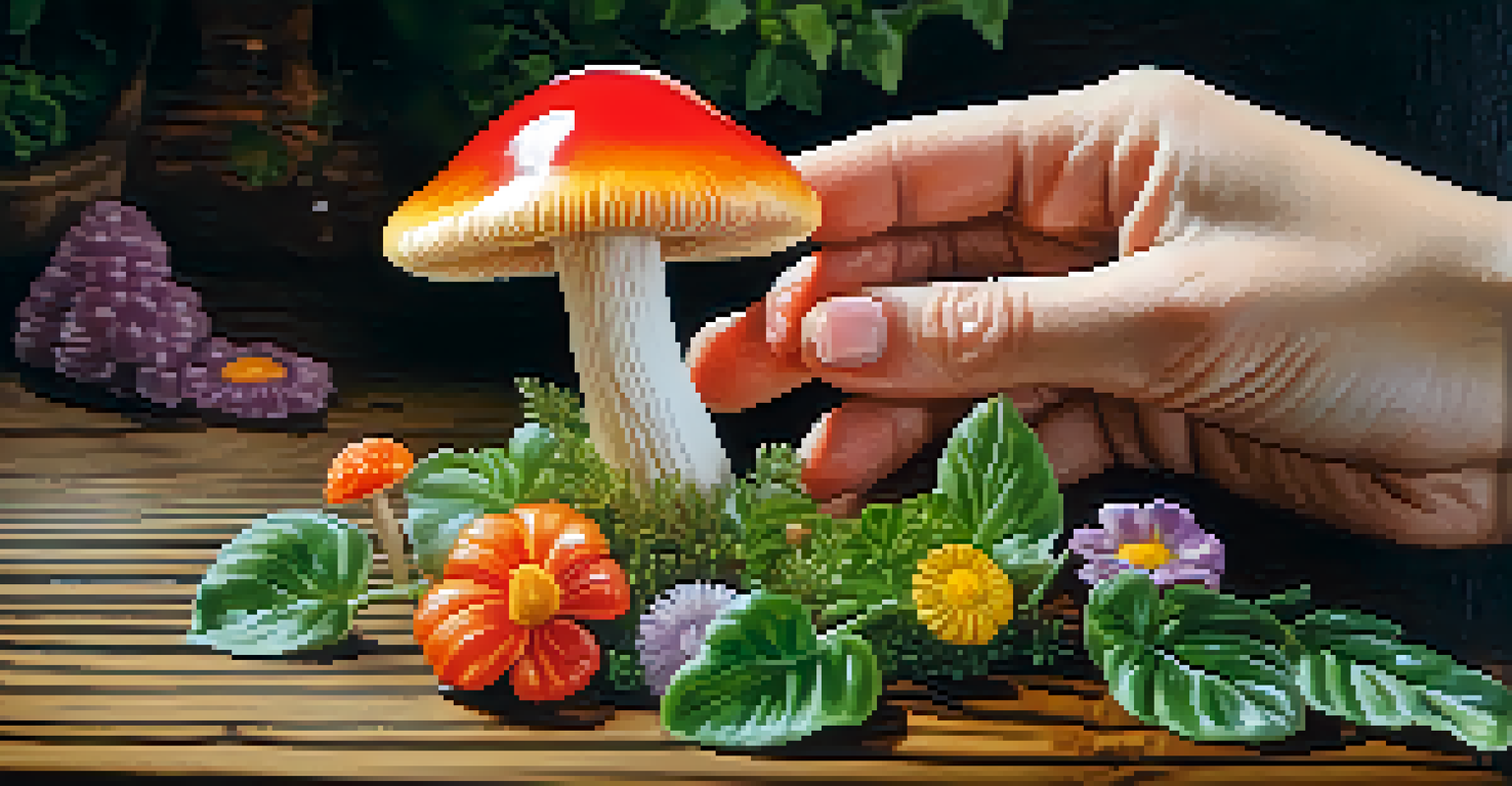Market Dynamics of the Entheogen Trade in Modern Economies

Understanding Entheogens: A Brief Overview
Entheogens are substances that induce altered states of consciousness, often used in spiritual or ceremonial contexts. These include naturally occurring plants like psilocybin mushrooms and ayahuasca, as well as synthetic substances. As society evolves, so does the understanding of these substances, leading to a resurgence in their use beyond traditional realms.
The use of entheogens can lead to profound personal insights and healing, a path that many are now choosing to explore.
In modern economies, entheogens are gaining recognition not only for their cultural significance but also for their potential therapeutic benefits. Research is increasingly showing their effectiveness in treating mental health issues such as depression and PTSD. This shift in perception is fostering a market that blends ancient practices with contemporary wellness trends.
The growing acceptance of entheogens is evident in various sectors, from healthcare to recreation. As more people seek alternative healing methods, the demand for entheogenic products is on the rise, creating a unique intersection of tradition and modernity.
Market Trends: Growth and Opportunities
The entheogen market has seen significant growth in recent years, driven by changing consumer attitudes and increasing scientific validation. Reports suggest that the global market could reach billions in the coming years, reflecting a shift towards holistic health approaches. This growth opens doors for entrepreneurs and investors interested in wellness and alternative therapies.

One notable trend is the rise of microdosing, where individuals consume sub-perceptual amounts of substances like psilocybin for cognitive enhancement. This practice has garnered attention from tech professionals and creatives seeking increased focus and creativity. As microdosing gains traction, companies are beginning to cater to this niche market.
Entheogens Gain Market Recognition
Entheogens are increasingly acknowledged for their therapeutic benefits and cultural significance, driving demand in both traditional and modern wellness sectors.
Moreover, the legal landscape is evolving, with some regions decriminalizing or legalizing certain entheogens. This progress not only validates their use but also creates a more stable market environment. As laws change, businesses can operate with greater confidence, further fueling market expansion.
Consumer Demographics: Who is Buying Entheogens?
The consumer base for entheogens is diverse and spans multiple demographics. Young adults, particularly those in urban areas, are leading the charge in exploring these substances for both recreational and therapeutic purposes. This group often seeks experiences that promote mindfulness and self-discovery, aligning with broader wellness trends.
In a time where mental health issues are on the rise, entheogens present a fascinating and promising avenue for treatment.
Interestingly, research shows that older adults are also increasingly turning to entheogens for mental health support. As stigma around these substances fades, more individuals from various age groups are seeking alternatives to conventional medicine. This intergenerational interest is reshaping the market landscape.
Additionally, the rise of social media and online communities has facilitated discussions around entheogens, making information more accessible. This digital engagement influences consumer behavior, as recommendations and shared experiences drive interest and purchases. As a result, the market is not only shaped by traditional demographics but also by the evolving nature of online interactions.
Challenges in the Entheogen Market: Legal and Ethical Issues
Despite the promising growth of the entheogen market, several challenges remain, particularly regarding legality and ethics. Many countries still classify entheogens as controlled substances, creating significant barriers for businesses. Navigating these regulations can be complex, requiring companies to stay informed and adaptable.
Moreover, the ethical implications of commercialization pose another hurdle. As the market grows, concerns arise about the potential exploitation of indigenous cultures and practices. Companies must tread carefully to ensure they honor traditional uses while also promoting their products responsibly in modern contexts.
Diverse Consumer Demographics Emerge
A wide range of consumers, from young adults to older individuals, are exploring entheogens for recreational and mental health purposes, influenced by reduced stigma and social media engagement.
Consumer education is essential in addressing these challenges. Companies that prioritize transparency and ethical sourcing can build trust with their customers. By fostering an informed community, the entheogen market can develop sustainably while respecting its deep-rooted cultural significance.
The Role of Research and Innovation in the Market
Research is playing a pivotal role in shaping the entheogen market, particularly in understanding their therapeutic applications. Studies exploring the effects of substances like MDMA and psilocybin are paving the way for new treatments in mental health. As scientific evidence accumulates, it bolsters the case for integrating these substances into conventional wellness practices.
Innovation within the industry is also essential for meeting consumer demand. Companies are experimenting with various delivery methods, such as gummies or capsules, to make entheogens more accessible. This adaptability not only attracts a broader audience but also enhances user experience.
Furthermore, collaborations between researchers, healthcare providers, and entrepreneurs are fostering a more comprehensive understanding of entheogens. By working together, these stakeholders can develop safe and effective products that cater to diverse needs. This synergy is key to the longevity and credibility of the entheogen market.
Sustainability: Sourcing and Environmental Impact
As the entheogen market expands, sustainability becomes an increasingly important consideration. Many entheogenic plants are harvested from the wild, raising concerns about overexploitation and environmental degradation. Ensuring that these resources are sourced responsibly is crucial for the planet and the communities that depend on them.
Innovative companies are looking into sustainable farming practices to cultivate entheogenic plants. By implementing techniques that promote biodiversity and reduce environmental impact, they can meet consumer demand while protecting ecosystems. This approach not only benefits the planet but also enhances brand reputation.
Entheogens Gain Cultural Acceptance
Entheogens are increasingly recognized for their therapeutic benefits and cultural significance, leading to a resurgence in their use.
Moreover, educating consumers about the importance of sustainability in the entheogen trade can drive demand for ethically sourced products. As awareness grows, more individuals are likely to prioritize sustainability in their purchasing decisions. This shift towards conscious consumerism can catalyze positive changes within the industry.
Future Outlook: The Next Steps for the Entheogen Market
The future of the entheogen market looks bright, with continued growth anticipated across various sectors. As societal acceptance increases and more research emerges, the market is poised for significant expansion. This evolution presents exciting opportunities for businesses and consumers alike.
One key area to watch is the potential for regulatory changes. As more jurisdictions reconsider their stance on entheogens, the market could experience a surge in legitimate businesses entering the space. This shift would not only boost economic growth but also enhance safety and accessibility for consumers.

Lastly, ongoing dialogue about the ethical implications of entheogen use will shape the market's trajectory. Stakeholders must collaborate to establish best practices that honor traditions while fostering innovation. By working together, the entheogen market can thrive sustainably, benefiting both individuals and society as a whole.